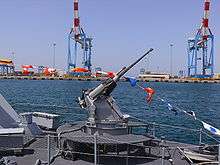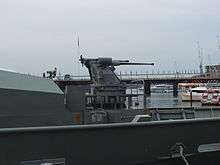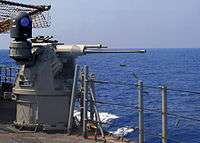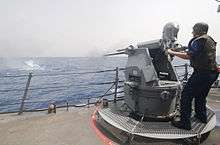Typhoon Weapon Station
The Typhoon is a type of remote weapon station manufactured by Rafael Advanced Defense Systems of Israel, and it shares similar design principles and common technologies with Samson Remote Controlled Weapon Station (Samson RCWS), a land-based system manufactured by the same developer. Like Samson RCWS, Typhoon is also multi-configurable.

The Typhoon, and its lightweight variant, Mini Typhoon, are used by the Israeli Navy, Indian Navy, Philippine Navy, Royal Australian Navy, Royal New Zealand Navy, the Republic of Singapore Navy,[1] Sri Lankan Navy and Singapore's Police Coast Guard.[2]
Overview
The first Typhoon, the Mk-23, was released in 1997. The weapon is mounted on a stabilized deck mounting which allows it to remain on target as the platform beneath it moves. The stabilizer has an accuracy of 0.25 milliradians (mrad), allowing it to keep the weapon aimed to within 250 millimetres (9.8 in) on a target 1,000 metres (3,300 ft) away.
The mounting does not penetrate the platform, making it relatively simple to fit the weapon to ships. Typhoon can use sights attached to the weapon mount or it can receive inputs from an independent Electro-Optical Detector (EOD) or Fire Control Radar (FCR). Using its own sight the Typhoon system can provide firing solutions entirely without outside assistance, allowing it to function fully independently.
The cannon system mounted can be an ATK, Oerlikon, Mauser or Giat model in the 20–30 mm caliber range. Between 160 and 210 rounds are carried on the mounting, depending on the caliber. The mount can traverse 120° to either side and elevate between -12.5° and 40.5°. The weight of a complete system is between 690 and 750 kilograms (1,520 and 1,650 lb) without ammunition, depending on the guns and sensors mounted.
By 2006, more than 120 Typhoon systems had been ordered.
Variants
Mini Typhoon
Mini Typhoon is a lightweight, remote-controlled weapon station based on the Typhoon.[3] It can be fitted with a .50 caliber machine gun, a 7.62 mm machine gun, or a 40 mm grenade launcher, with a magazine of up to 230 rounds.[3] The system has an accuracy rating of 0.5 mrad, weighs between 140 and 170 kilograms (310 and 370 lb), depending on the weapon fitted, and can be installed without structural penetration of a ship's deck.[3] The mini Typhoon is also mounted on the Protector USV (unmanned surface vehicle) Mk49 Mod 0.[4]
Typhoon Mk-30c
Typhoon Mk-30c is a new variant equpped with the 30mm Mk44 Bushmaster II and 200 ready use rounds. [5]
Operators
.png)



Current operators
- Adelaide class frigate (retired) - Mini Typhoon as a temporary mount for deployments to the Middle East.[3]
- Armidale class patrol boat - 25mm M242 Bushmaster
- Anzac class frigate - Mini Typhoon as a temporary mount for deployments to the Middle East.[3]
- Canberra-class landing helicopter dock[6]
- Hobart class destroyer - 25mm M242 Bushmaster
- Supply-class replenishment oiler 25mm M242 Bushmaster
- Halifax-class frigate - Mini Typhoon as mount
- Harry DeWolf-class offshore patrol vessel - Mk38 Mod2 as main gun
- Super Dvora Mk II class patrol boat

- Shaldag class fast patrol boat
- Super Dvora Mk II class patrol boat
- Super Dvora Mk III class patrol boat
- Sa'ar 4.5 class missile boat
- Anzac class frigate - Mini Typhoon as a permanent mount.[3] with M2 Browning machine guns
- Protector-class offshore patrol vessel - 1 x 25 mm[7]
- Endurance class landing platform dock ships - 2× 25mm Mk38 Mod2 (mounted amidships on port and starboard side)[1]
- Formidable-class frigate Mk38 Mod2
- Bedok-class mine countermeasures vessel - Mk25
- Protector USV - Mini Typhoon Mk49 Mod0[4]
- New Coastal Patrol Craft (NCPC) for the Police Coast Guard.[2]
- Gregorio del Pilar class frigate - Mk. 38 Mod 2
- Multi-purpose Attack Craft - Mini Typhoon and Typhoon MLS-ER
- Colombo class FACs
- Shaldag class fast patrol boat
- Super Dvora Mk II class patrol boat
- Super Dvora Mk III class patrol boat
- Typhoon Weapon System has been selected by the US Navy, designated Mk38 Mod2, and provided by the US-located branch of the UK-headquartered company BAE Systems teamed with Rafael.[8]
- Mini-Typhoon selected by the US Navy as the Remote Operated Small Arms Mount (ROSAM), designated Mk 49 Mod 1. The combination Spike missile/12.7mm armed variant has been tested on an unmanned vessel.[9]
References
- Notes
- "RSN - Assets - Weapons". Ministry of Defence (Singapore) (MINDEF). 23 July 2010. Archived from the original on 20 July 2008. Retrieved 15 September 2010.
- Muhammad Juffry, Bin Joihani (Jul–Aug 2009). "PCG upgrades with new fleet and training centre". Police Life Monthly. Singapore: Singapore Police Force. 35 (7). ISSN 0217-8699. Archived from the original on 22 June 2011. Retrieved 8 November 2010.
- Scott, Richard (12 December 2007). "Enhanced small-calibre systems offer shipborne stopping power". International Defence Review. Jane's Information Group.
- "RSN - Assets - Unmanned Surface Vehicles". MINDEF. 2 June 2010. Archived from the original on 14 February 2014. Retrieved 15 September 2010.
- https://www.rafael.co.il/wp-content/uploads/2019/03/Typhoon-Mk-30c-1.pdf
- "Future Royal Australian Navy LHD HMAS Canberra received its four Typhoon RWS". January 4, 2014. Archived from the original on January 4, 2014. Retrieved January 4, 2014.
- "Archived copy". Archived from the original on 2015-07-21. Retrieved 2015-07-18.CS1 maint: archived copy as title (link)
- "Archived copy" (PDF). Archived from the original (PDF) on 2012-12-02. Retrieved 2012-09-18.CS1 maint: archived copy as title (link)
- http://defense-update.com/20121031_us-navy-tests-rafael-spike-missiles-on-unmanned-vessels.html Archived 2013-01-17 at the Wayback Machine US Navy Tests Rafael Spike Missiles on Unmanned vessels
External links

- TYPHOON Naval Stabilized Weapon Station
- MINI-TYPHOON Naval Stabilized Weapon Station
- Video links